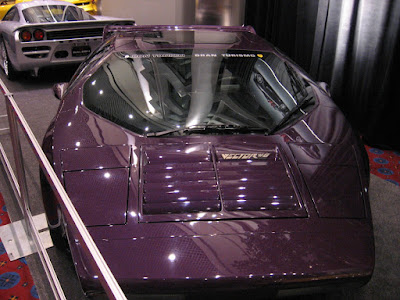The first Oscar Mayer Wienermobile was created in 1936. This is an example of the 10th generation, six of which were built in 2004 by Prototype Source of Santa Barbara, California. Based on a GMC W-Series chassis and powered by a 300-horsepower 6.0-liter Vortec 6000 V8 engine, it features gull-wing doors, voice-activated GPS navigation, an audio center with a wireless microphone, a horn that plays the Wiener Jingle in 21 different genres, and taillights from the 4th generation Pontiac Firebird. I saw it heading north on Interstate 5 near Salem, Oregon, on April 19, 2006.
Sunday, June 16, 2024
Thursday, June 6, 2024
Dodge Magnum R/T
Sharing the LX platform with the Chrysler 300, the Dodge Magnum was introduced in 2004 for the 2005 model year and was on Car and Driver’s 10Best list for 2005. The R/T version shown here was the top of the line in 2005, powered by the new 340-horsepower 5.7-liter Hemi V8 engine with a Mercedes-Benz derived 5-speed Auto/Stick® automatic transmission. Additional standard features for the Magnum R/T included leather-trimmed seats, leather-wrapped steering wheel and shift knob, Boston Acoustics 6-speaker sound system with 288-watt digital amplifier, 18-inch polished aluminum wheels, fog lamps and stainless steel dual exhaust with bright tips. It was also available with Mercedes-Benz’s 4MATIC all-wheel drive system with unique 18-inch aluminum wheels.
Sunday, June 2, 2024
Dodge Neon SRT4
The Dodge Neon was introduced in 1994 and the second generation debuted in 2000. Alongside a facelift in 2003, the SRT4 model was introduced. Powered by a 2.4-liter inline 4-cylinder engine with a Mitsubishi turbocharger and featuring a 5-speed manual transmission, the 2003 Neon SRT4 was rated at 215 horsepower and 245 foot-pounds of torque. It could accelerate from 0 to 60 miles per hour in 5.6 seconds and cover a quarter mile in 14.1 seconds at 102 miles per hour, and was the second-fastest stock production vehicle in the Chrysler/Dodge lineup, second only to the V10-powered Viper.
In 2004, larger fuel injectors and a recalibrated engine computer increased output to 230 horsepower and 250 foot-pounds of torque, reducing the 0-60 time to 5.3 seconds and the quarter mile time 3.9 seconds at 103 miles per hour. The SRT4 was discontinued with the rest of the Neon platform after 2005.
Monday, May 27, 2024
2005 Ford Taurus SE
Standard equipment included a 155-horsepower 3.0-liter overhead valve 12-valve V6 Vulcan engine with 185 foot-pounds of torque, a 4-speed electronic automatic transmission with overdrive lockout, power rack-and-pinion steering with variable assist, 4-wheel power front disc-rear drum brakes, power windows with one-touch down driver’s-side feature, power door locks, power sideview mirrors, tilt steering column, speed control with steering-wheel-mounted illuminated controls and air conditioning.
This example included the optional 16” 5-spoke painted-aluminum wheels, 60/40 split-folding rear seat, and the 6-way power driver’s seat with lumbar support.
Another included option was the 5-passenger cloth seating with front bucket seats and floor-mounted shifter and console.
Sunday, May 19, 2024
BMW 507 Model
The BMW display at the 2006 and 2007 Portland International Auto Shows featured some display cases with BMW accessories and memorabilia, and models of past and present BMW cars, including this model of the BMW 507.
The BMW 507 roadster was produced from 1956 to 1959, with a body made entirely of aluminum. Only 252 of the V8-powered sports cars were built, as BMW lost money on every one sold. One of them was owned by Elvis Presley.
BMW 503 Model
The BMW displays at the 2006 and 2007 Portland International Auto Show featured some display cases with BMW accessories and memorabilia, and models of past and present BMW cars, including this model of the BMW 503.
The BMW 503 was produced as a coupe and convertible from 1955 to 1960. Only 412 were built: 273 coupes and 129 convertibles. The 503 was powered by Germany's first postwar V8, a 3.2-liter 140-horsepower engine capable of accelerating the 503 to 118 miles per hour. The 507 convertibles were the first German cars to feature electrically-operated power tops.
Vector W8
This is a rare Vector W8. Built in 1992 and 1993, only 17 consumer models were built. The W8 is powered by an aluminum-alloy 6.0-liter twin-turbocharged V8 producing over 600 horsepower.
This is apparently the only W8 painted purple. It was displayed at the 2006 Portland International Auto Show by Ron Tonkin Gran Turismo. When new, the W8 retailed for around $455,000.00.

























